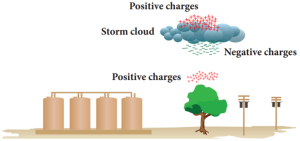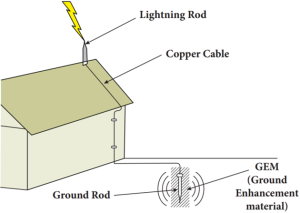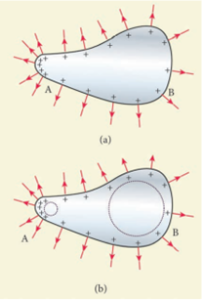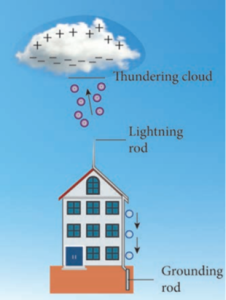6. Electricity
Primary Cell – Simply Dry Cell:
- A dry cell is a type of chemical cell commonly used in the common form batteries for many electrical appliances.
- It is a convenient source of electricity available in portable and compact form.
- It was developed in 1887 by Yei Sakizo of Japan.
- Dry cells are normally used in small devices such as remote control for T.V., torch, camera and toys.
- A dry cell is a portable form of a leclanche cell.
- It consists of zinc vessel which acts as a negative electrode or anode.
- The vessel contains a moist paste of saw dust saturated with a solution of ammonium chloride and zinc chloride.
- The ammonium chloride acts as an electrolyte.
- The purpose of zinc chloride is to maintain the moistness of the paste being highly hygroscopic.
- The carbon rod covered with a brass cap is placed in the middle of the vessel.
- It acts as positive electrode or cathode.
- It is surrounded by a closely packed mixture of charcoal and manganese dioxide (MnO2) in a muslin bag.
- Here MnO2 acts as depolarizer.
- The zinc vessel is sealed at the top with pitch or shellac.
- A small hole is provided in it to allow the gases formed by the chemical action to escape.
- The chemical action inside the cell is the same as in leclanche cell.
Lightning, Thunder and Earthing:
- Getting a shock from a door knob after rubbing your foot on a carpet floor, results from discharge.
- Discharge occurs when electrons on the hand are quickly pulled to the positively charged doorknob.
- This movement of electrons, which is felt as a shock, causes the body to lose negative charge.
- Electric discharge takes place in a medium, mostly gases.
- Lightning is another example of discharge that takes place in clouds.
- Lightning is produced by discharge of electricity from cloud to cloud or from cloud to ground.
- During thunderstorm air is moving upward rapidly.
- This air which moves rapidly, carries small ice crystals upward.
- At the same time, small water drops move downward.
- When they collide, ice crystals become positively charged and move upward and the water drops become negatively charged and move downward.
- So the upper part of the cloud is positively charged and the lower part of the cloud is negatively charged.
- When they come into contact, electrons in the water drops are attracted by the positive charges in the ice crystals.
- Thus, electricity is generated and lightning is seen.
- Sometimes the lower part of the cloud which is negatively charged comes into contact with the positive charges accumulated near the mountains, trees and even people on the earth.
- This discharge produces lot of heat and sparks that results in what we see as lightning. Huge quantities of electricity are discharged in lightning flashes and temperatures of over 30,000°C or more can be reached.
- This extreme heating causes the air to expand explosively fast and then they contract.
- This expansion and contraction create a shock wave that turns into a booming sound wave, known as thunder.
- Sometimes lightning may be seen before the thunder is heard.
- This is because the distance between the clouds and the surface is very long and the speed of light is more than the speed of sound.

Earthing:
- A safety measure devised to prevent people from getting shocked if the insulation inside electrical devices fails is called earthing.
- Electrical earthing can be defined as the process of transferring the discharge of electrical energy directly to the earth with the help of low-resistance wire.
- We get electrical energy from different sources.
- Battery is one such source.
- We use it in wall clocks, cell phones etc.
- For the working of refrigerators, air conditioners, washing machines, televisions, laptops and water heaters we use domestic power supply.
- Usually an electric appliance such as a heater, an iron box, etc. are fitted with three wires namely live, neutral and earth.
- The earth wire is connected to the metallic body of the appliance.
- This is done to avoid accidental shock.
- Suppose due to some defect, the insulation of the live wire inside an electric iron is burnt then the live wire may touch the metallic body of the iron.
- If the earth wire is properly connected to the metallic body, current will pass into the earth through earth wire and it will protect us from electric shock.
- The earth, being a good conductor of electricity, acts as a convenient path for the flow of electric current that leaks out from the insulation.
Lightning Arresters:
- Lightning arrestor is a device used to protect buildings from the effects of lightning.
- Lightning conductor consists of a metallic lightning rod (in the form of spikes) that remains in air at the top of the building.
- Major portion of the metal rod and copper cable are installed in the walls during its construction.
- The other end of the rod is placed deep into the soil.
- When lightning falls, it is attracted by the metallic rods at the top of the building.
- The rod provides easy route for the transfer of electric charge to the ground.
- In the absence of lightning arrestors, lightning will fall on the building and the building will be damaged.

Ohm’s Law:
- A German physicist, Georg Simon Ohm established the relation between the potential difference and current, which is known as Ohm’s Law.
- This relationship can be understood from the following activity.
- According to Ohm’s law, at a constant temperature, the steady current ‘I’ flowing through a conductor is directly proportional to the potential difference ‘V’ between the two ends of the conductor.
- I V. Hence, I / V = constant.
- The value of this proportionality constant is found to be 1 / R
Therefore, I = ( 1 / R ) V
V = IR
- Here, R is a constant for a given material (say Nichrome) at a given temperature and is known as the resistance of the material.
- Since, the potential difference V is proportional to the current I, the graph between V and I is a straight line for a conductor.
Resistors in series:
- Thus, if resistors are connected end to end, so that the same current passes through each of them, then they are said to be connected in series.
RS = R1 + R2 + R3
Resistances in Parallel:
- Thus, when a number of resistors are connected in parallel, the sum of the reciprocals of the individual resistances is equal to the reciprocal of the effective or equivalent resistance.
- When ‘n’ resistors of equal resistances R are connected in parallel, the equivalent resistance is R / n.

Joule’s Law of Heating:
- Let ‘I’ be the current flowing through a resistor of resistance ‘R’, and ‘V’ be the potential difference across the resistor.
- The charge flowing through the circuit for a time interval’s’ is ‘Q’.
- The work done in moving the charge Q across the ends of the resistor with a potential difference of V is VQ.
- This energy spent by the source gets dissipated in the resistor as heat.
- Thus, the heat produced in the resistor is:
H = W = VQ
You know that the relation between the charge and current is Q = I t. Using this, you get
H = V I t
From Ohm’s Law, V = I R. Hence, you have
H = I2 R t
- This is known as Joule’s law of heating.
- Joule’s law of heating states that the heat produced in any resistor is:
- Directly proportional to the square of the current passing through the resistor.
- Directly proportional to the resistance of the resistor.
- Directly proportional to the time for which the current is passing through the resistor.
Applications of Heating Effect:
Electric Heating Device:
- The heating effect of electric current is used in many home appliances such as electric iron, electric toaster, electric oven, electric heater, geyser, etc.
- In these appliances Nichrome, which is an alloy of Nickel and Chromium is used as the heating element. Why? Because:
- It has high resistivity, (ii) It has a high melting point, (iii) It is not easily oxidized.
Fuse Wire:
- The fuse wire is connected in series, in an electric circuit.
- When a large current passes through the circuit, the fuse wire melts due to Joule’s heating effect and hence the circuit gets disconnected.
- Therefore, the circuit and the electric appliances are saved from any damage.
- The fuse wire is made up of a material whose melting point is relatively low.
Filament in bulbs:
- In electric bulbs, a small wire is used, known as filament.
- The filament is made up of a material whose melting point is very high.
- When current passes through this wire, heat is produced in the filament.
- When the filament is heated, it glows and gives out light.
- Tungsten is the commonly used material to make the filament in bulbs.
Domestic Electric Circuits:
- The electricity produced in power stations is distributed to all the domestic and industrial consumers through overhead and underground cables.
- The diagram, which shows the general scheme of a domestic electric circuit.
- In our homes, electricity is distributed through the domestic electric circuits wired by the electricians.
- The first stage of the domestic circuit is to bring the power supply to the main-box from a distribution panel, such as a transformer.
- The important components of the main-box are:
- a fuse box and
- a meter.
- The meter is used to record the consumption of electrical energy.
- The fuse box contains either a fuse wire or a miniature circuit breaker (MCB).
- The function of the fuse wire or a MCB is to protect the house hold electrical appliances from overloading due to excess current.
- An MCB is a switching device, which can be activated automatically as well as manually.
- It has a spring attached to the switch, which is attracted by an electromagnet when an excess current passes through the circuit.
- Hence, the circuit is broken and the protection of the appliance is ensured.
- The electricity is brought to houses by two insulated wires.
- Out of these two wires, one wire has a red insulation and is called the ‘live wire’.
- The other wire has a black insulation and is called the ‘neutral wire’.
- The electricity supplied to your house is actually an alternating current having an electric potential of 220 V.
- Both, the live wire and the neutral wire enter into a box where the main fuse is connected with the live wire.
- After the electricity meter, these wires enter into the main switch, which is used to discontinue the electricity supply whenever required.
- After the main switch, these wires are connected to live wires of two separate circuits.
- Out of these two circuits, one circuit is of a 5 A rating, which is used to run the electric appliances with a lower power rating, such as tube lights, bulbs and fans.
- The other circuit is of a 15 A rating, which is used to run electric appliances with a high power rating, such as air-conditioners, refrigerators, electric iron and heaters.
- It should be noted that all the circuits in a house are connected in parallel, so that the disconnection of one circuit does not affect the other circuit.
- One more advantage of the parallel connection of circuits is that each electric appliance gets an equal voltage.
Overloading and Short Circuiting:
- The fuse wire or MCB will disconnect the circuit in the event of an overloading and short circuiting.
- Over loading happens when a large number of appliances are connected in series to the same source of electric power.
- This leads to a flow of excess current in the electric circuit.
- When the amount of current passing through a wire exceeds the maximum permissible limit, the wires get heated to such an extent that a fire may be caused. This is known as overloading.
- When a live wire comes in contact with a neutral wire, it causes a ‘short circuit’.
- This happens when the insulation of the wires get damaged due to temperature changes or some external force.
- Due to a short circuit, the effective resistance in the circuit becomes very small, which leads to the flow of a large current through the wires.
- This results in heating of wires to such an extent that a fire may be caused in the building.
- In domestic circuits, a third wire called the earth wire having a green insulation is usually connected to the body of the metallic electric appliance.
- The other end of the earth wire is connected to a metal tube or a metal electrode, which is buried into the Earth.
- This wire provides a low resistance path to the electric current.
- The earth wire sends the current from the body of the appliance to the Earth, whenever a live wire accidentally touches the body of the metallic electric appliance.
- Thus, the earth wire serves as a protective conductor, which saves us from electric shocks.
Led Bulb and Led Television:
- An LED bulb is a semiconductor device that emits visible light when an electric current passes through it.
- The colour of the emitted light will depend on the type of materials used.
- With the help of the chemical compounds like Gallium Arsenide and Gallium Phosphide, the manufacturer can produce LED bulbs that radiates red, green, yellow and orange colours.
- Displays in digital watches and calculators, traffic signals, street lights, decorative lights, etc., are some examples for the use of LEDs.
Seven Segment Display:
- A ‘Seven Segment Display’ is the display device used to give an output in the form of numbers or text.
- It is used in digital meters, digital clocks, micro wave ovens, etc.
- It consists of 7 segments of LEDs in the form of the digit 8.
- These seven LEDs are named as a, b, c, d, e, f and g. An extra 8th LED is used to display a dot.

Merits of a LED bulb:
- As there is no filament, there is no loss of energy in the form of heat. It is cooler than the incandescent bulb.
- In comparison with the fluorescent light, the LED bulbs have significantly low power requirement.
- It is not harmful to the environment.
- A wide range of colours is possible here.
- It is cost-efficient and energy efficient.
- Mercury and other toxic materials are not required.
- One way of overcoming the energy crisis is to use more LED bulbs.
LED Television:
- LED Television is one of the most important applications of Light Emitting Diodes.
- An LED TV is actually an LCD TV (Liquid Crystal Display) with LED display.
- An LED display uses LEDs for backlight and an array of LEDs act as pixels.
- LEDs emitting white light are used in monochrome (black and white) TV; Red, Green and Blue (RGB) LEDs are used in colour television.
- The first LED television screen was developed by James P. Mitchell in 1977.
- It was a monochromatic display.
- But, after about three decades, in 2009, SONY introduced the first commercial LED Television.
Advantages of LED television:
- It has brighter picture quality.
- It is thinner in size.
- It uses less power and consumes very less energy.
- Its life span is more.
- It is more reliable.
Action of Points or Corona Discharge:
- Consider a charged conductor of irregular shape.
- We know that smaller the radius of curvature, the larger is the charge density.
- The end of the conductor which has larger curvature (smaller radius) has a large charge accumulation.
- As a result, the electric field near this edge is very high and it ionizes the surrounding air.
- The positive ions are repelled at the sharp edge and negative ions are attracted towards the sharper edge.
- This reduces the total charge of the conductor near the sharp edge. This is called action of points or corona discharge.

Lightning arrester or lightning conductor:
- This is a device used to protect tall buildings from lightning strikes.
- It works on the principle of action at points or corona discharge.
- This device consists of a long thick copper rod passing from top of the building to the ground.
- The upper end of the rod has a sharp spike or a sharp needle.
- The lower end of the rod is connected to copper plate which is buried deep into the ground.
- When a negatively charged cloud is passing above the building, it induces a positive charge on the spike.
- Since the induced charge density on thin sharp spike is large, it results in a corona discharge.
- This positive charge ionizes the surrounding air which in turn neutralizes the negative charge in the cloud.
- The negative charge pushed to the spikes passes through the copper rod and is safely diverted to the Earth.
- The lightning arrester does not stop the lightning; rather it diverts the lightning to the ground safely.

Problems:
- Three resistors of resistances 5 ohm, 3 ohm and 2 ohm are connected in series with 10 V battery. Calculate their effective resistance and the current flowing through the circuit.
Solution:
R1 = 5 Ω, R2 = 3 Ω, R3 = 2 Ω, V = 10 V
Rs = R1 + R2 + R3, Rs = 5 + 3 + 2 = 10, hence
Rs = 10 Ω
The current, 
- An electric heater of resistance 5 Ω is connected to an electric source. If a current of 6 A flows through the heater, then find the amount of heat produced in 5 minutes.
Solution:
Given resistance R = 5 Ω, Current I = 6 A, Time t = 5 minutes = 5 × 60 s = 300 s
Amount of heat produced, H = I2 Rt, H = 62 × 5 × 300. Hence, H = 54000 J
- In the circuit diagram given below, three resistors R1, R2 and R3 of 5 Ω, 10 Ω and 20 Ω respectively are connected as shown. Calculate:
- Current through each resistor
- Total current in the circuit
- Total resistance in the circuit
Solution:
Since the resistors are connected in parallel, the potential difference across each resistor is same (i.e. V=10V) Therefore, the current through R1 is,
I1 = V / R1 =10 / 5 = 2A
Current through R2 = I2 = V / R2 = 10 / 10 = 1A
Current through R3 = I3 = V / R3 = 10 / 20 = 0.5A
Total current in the circuit, I = I1 + I2 + I3 = 2 + 1 + 0.5 = 3.5 A
Total resistance in the circuit 1/RP = 1/R1 + 1/R2 + 1/R3
= 1/5 + 1/10 + 1/20
= 4 + 2 + 1 / 20
1 / RP = 7 / 20
Hence, RP = 20 / 7 = 2.857 Ω
- Three resistors of 1 Ω, 2 Ω and 4 Ω are connected in parallel in a circuit. If a 1 Ω resistor draws a current of 1 A, find the current through the other two resistors.
Solution:
R1 = 1 Ω, R2 = 2 Ω, R3 = 4 Ω Current I1 = 1 A
The potential difference across the 1 Ω resistor = I1 R1 = 1 × 1 = 1 V
Since, the resistors are connected in parallel in the circuit, the same potential difference will exist across the other resistors also.
So, the current in the 2 Ω resistor, V / R2 = 1 / 2 = 0.5A
Similarly, the current in the 4 Ω resistor, V / R3 = 1 / 4 = 0.25A
